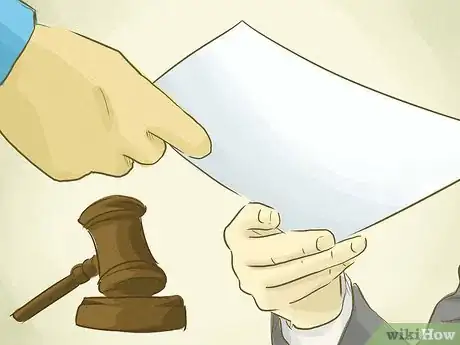This article was co-authored by Clinton M. Sandvick, JD, PhD. Clinton M. Sandvick worked as a civil litigator in California for over 7 years. He received his JD from the University of Wisconsin-Madison in 1998 and his PhD in American History from the University of Oregon in 2013.
There are 10 references cited in this article, which can be found at the bottom of the page.
This article has been viewed 21,334 times.
Generally, a party in a lawsuit files a motion in limine to exclude evidence from a trial because the evidence isn’t relevant or because its prejudicial effect substantially outweighs its probative value. You can oppose the motion in limine by drafting and filing your own motion in opposition. The judge will probably hold a brief hearing and then rule on to the motion.
Steps
Analyzing the Motion
-
1Read the motion. The other side should send you a copy of their motion in limine around the time it is filed. It might be mailed or hand delivered. You and the other side should have agreed ahead of time how you would receive notice of motions filed in the case.
- As soon as you get a copy of the motion, you should sit down and read it.
-
2Identify what information the other side wants to exclude. Parties can file motions in limine to exclude all sorts of information from being brought up at trial. As you read the motion, identify what information the other side wants excluded. For example, motions in limine are often brought for the following reasons:
- To prevent an attorney from using prejudicial language. For example, referring to a car crash as a “fender bender” might be prejudicial.[1]
- To prevent an attorney from mentioning prior crimes. For example, if a defendant is sued for fraud, then the plaintiff might want to bring up that the defendant has previously been convicted of a violent crime.
- To keep out evidence disallowed by the rules of evidence. Each state (and the federal government) has rules of evidence that prevent some kinds of evidence from being introduced. For example, you can’t introduce evidence that a defendant has liability insurance to prove that the person was negligent.[2]
Advertisement -
3Check the deadline for responding. Make note of when your response is due. You probably don’t have much time. You can read the judge’s local rules for information on the timing of motions.
- If there isn’t any information in the local rules, then read the relevant Rules of Civil Procedure. If you are in federal court, then read the Federal Rules of Civil Procedure. If you are in state court, then read your state’s Rules of Civil Procedure.
-
4Read any rules or court opinions cited. Look at the argument section of the other side’s motion in limine and find out what legal authority they cite in support of their argument. Generally, they will cite to either Rules of Evidence or to court opinions. You should find any rule or court opinion and check to see that it really stands for what the other side claims.
- You can find the Federal Rules of Evidence online.[3] Many states also publish their evidentiary rules online as well.
- You can find court opinion on Google Scholar.[4] Click on “Case law” and then enter the case citations, e.g., 211 2Fd. 206. You should print off the opinion so that you have a copy.
-
5Brainstorm counterarguments. If you want to oppose the motion in limine, then you need legitimate reasons for doing so. Your counterarguments will depend on the circumstances of the case. However, you generally can raise the following counterarguments:
- The evidence isn’t prejudicial. For example, in a fraud trial, the defendant might want to prevent the plaintiff from using the word “lying.” You could argue that this word is no more prejudicial than any other word used to describe a deliberate misrepresentation.
- The prejudice doesn’t outweigh the probative value. The evidence might be prejudicial. However, the court typically can’t exclude it unless the prejudice “substantially” outweighs the probative value.
- You are introducing the evidence for an alternative purpose. Some evidence might be prejudicial but nevertheless have a legitimate reason for being introduced. For example, in an automobile accident case, you could introduce proof of someone’s liability insurance to show that they owned the vehicle.[5]
-
6Analyze whether your counterarguments are frivolous. You can’t file a frivolous motion with the court. If you do, then you could be sanctioned. For example, you may be ordered to pay a financial penalty or to reimburse the other side’s legal fees.[6]
- Accordingly, you should analyze your counterarguments to see if you have a reasonable argument. If you don’t, then don’t file the motion.
-
7Meet with an attorney. You might have questions or need help deciding whether to oppose the motion in limine. You can meet with a qualified attorney and ask questions. To get a referral, you can contact your local or state bar association.
- Once you have a referral, call and schedule a meeting. Ask how much the attorney charges.
- Take the other side’s motion so that the attorney can read it. If you don’t have the time to draft your own motion or do legal research, then ask if you could hire the attorney to draft your response for you.
Drafting Your Opposition Motion
-
1Format the document. To formally oppose the motion in limine, you need to draft your own motion in opposition. You should begin by setting up your motion so that it looks like other documents in your case. Create a one-inch margin on all sides and set the font to a comfortable size and style. Generally, motions are typed in 14 point Times New Roman or Arial font.
- You might have to use “pleading paper,” which is paper numbered down the left-hand side. Read your local rules.
-
2Add the caption information. The caption includes the name of the court, as well as the parties’ names and the case number.[7] It may also include the judge’s name. Look at any document filed in your case to get the caption information.
- Also add a title. You can title your motion something like “Plaintiff’s Opposition Motion to Defendant’s Motion in Limine to Exclude Evidence of Liability Insurance” or something appropriate.
-
3Insert an introduction. Identify who you are and the purpose of your motion. You could write, for example, “Plaintiff, Ann Smith, representing herself pro se, hereby opposes the Defendant’s Motion in Limine to prevent any mention of Defendant’s liability insurance.”
-
4Make your argument. You should explain why the other side’s motion in limine should be denied and why you should be free to introduce the evidence at trial if you choose. Try to support your argument with citations to court rules or to case opinions which support your argument.
- For example, you could write: “Defendant’s request to exclude evidence of his liability insurance should be denied. Plaintiff intends to introduce the evidence to show that Defendant owns the vehicle, which is allowed by Rule 411 of the Federal Rules of Evidence. Rule 411 only prohibits introduction of this evidence as proof of negligence. However, Plaintiff does not intend to introduce the evidence for that purpose.”
-
5Add a conclusion. Keep the conclusion brief. Simply request that the court deny the other side’s motion in limine. For example, you could write:
- “For the foregoing reasons, the Defendant’s Motion in Limine to Exclude Evidence of Liability Insurance should be denied.”
-
6Sign your motion. Beneath the conclusion, you should insert “Respectfully submitted” and then a line for your signature. Beneath the signature line, insert your name, address, telephone number, and email address.
-
7Create a certificate of service. You need to give the other side a copy of your motion, and you need to let the court know that you served it on the other side. Be sure to mention the date you sent the copy and the method of delivery.
- Put the certificate on a separate sheet of paper and title it “Certificate of Service” in all caps and bold.
- Sample language could read: “I hereby certify that on this [insert date], copies of the foregoing Plaintiff’s Opposition to Defendant’s Motion in Limine to Exclude Evidence of Liability Insurance was hand delivered to: [insert the name and address of the other side’s lawyer].” Then add a signature line and sign the certificate.
Filing Your Motion
-
1Make several copies. Some courts require that you file multiple copies along with the original. Read your court’s rules. You should also keep a copy of all documents that you file in your case.
- The judge might also want a courtesy copy delivered to his or her chambers. Check the judge’s rules.[8]
-
2Serve a copy on the other side. You need to send the other side a copy of your motion using the method you stated in your certificate of service. You need to give sufficient advance notice before the hearing. The Rules of Civil Procedure and the local rules should state how much advance notice you need to give.
- For example, if you provide notice by mail, then some courts will require that you add on five days for the motion to arrive to the other side. This means that if your rules require that you provide notice nine days before the hearing, then you will have to mail the notice 14 days before the hearing.
-
3File your motion with the court. Take your copies and the original to the court clerk and ask to file.[9] The clerk should stamp your copies with the filing date.
- In some courts, particularly federal court, you may file the motion electronically.[10] If you filed electronically, then the electronic system will probably notify the other side that the motion has been filed.
Arguing the Motion in Court
-
1Read all of the motions to prepare. During the hearing, the judge could ask you a question about either your motion or the other side’s motion, so you should reread them so that you understand them inside and out. Also pull copies of all court cases or rules cited in the motions and make sure that you are familiar with them.
-
2Outline your argument. You should create bullet points of the main issues you want to hit. The purpose of argument isn’t to read from a text. Instead, you want to talk to the judge. Understand your arguments and lead off with your strongest.
- You probably won’t get a lot of time to talk, so keep your remarks as brief as possible. A few short, clear statements is best.[11]
-
3Listen to the other side. The person filing the motion in limine will go first at your hearing. Listen quietly. They shouldn’t raise any arguments that weren’t raised in their motion. If they do, then make note of the arguments and bring them up to the judge when it is your turn to speak.
- The judge may also ask questions.[12] Listen closely. The judge’s questions provide a sneak peek as to what the judge is most interested in.
- If the judge seems particularly interested in one issue, then lead off with that issue when it is your turn to speak.
-
4Make your argument. Speak clearly and with confidence. Make your top two or three points as to why the motion in limine should be denied. If the judge has questions, listen quietly and don’t guess when answering.
- Always refer to the judge as “Your Honor.”[13] You can refer to the other side as “my opponent” or “the plaintiff/defendant.”
-
5Await the decision. The judge should make a decision on motions in limine soon after hearing argument on them.[14] If you lose, remember that you can try to appeal the issue later on (if you lose at trial).
- Also, if the judge excludes the evidence, then be careful not to accidentally introduce the evidence during trial. You could be sanctioned or the judge could declare a mistrial.
References
- ↑ http://legaldictionary.net/motion-in-limine/
- ↑ https://www.law.cornell.edu/rules/fre/rule_411
- ↑ https://www.law.cornell.edu/rules/fre
- ↑ https://scholar.google.com/
- ↑ https://www.law.cornell.edu/rules/fre/rule_411
- ↑ https://www.law.cornell.edu/rules/frcp/rule_11
- ↑ http://www.peoples-law.org/filing-motion-maryland-circuit-court
- ↑ https://www.nyed.uscourts.gov/pub/rules/ADS-MLR.pdf
- ↑ http://www.civillawselfhelpcenter.org/self-help/lawsuits-for-money/pre-trial-stage-filing-and-opposing-motions/247-opposing-a-motion-filed-against-you
- ↑ https://www.nyed.uscourts.gov/pub/rules/ADS-MLR.pdf
- ↑ http://www.washingtonlawhelp.org/resource/basic-tips-on-how-to-prepare-for-a-court-hear?ref=XTySM
- ↑ http://www.civillawselfhelpcenter.org/self-help/lawsuits-for-money/pre-trial-stage-filing-and-opposing-motions/247-opposing-a-motion-filed-against-you
- ↑ http://blogs.findlaw.com/strategist/2014/01/courtroom-etiquette-101-speaking-to-judges.html
- ↑ http://www.civillawselfhelpcenter.org/self-help/lawsuits-for-money/pre-trial-stage-filing-and-opposing-motions/247-opposing-a-motion-filed-against-you









-Step-1.webp)







































































